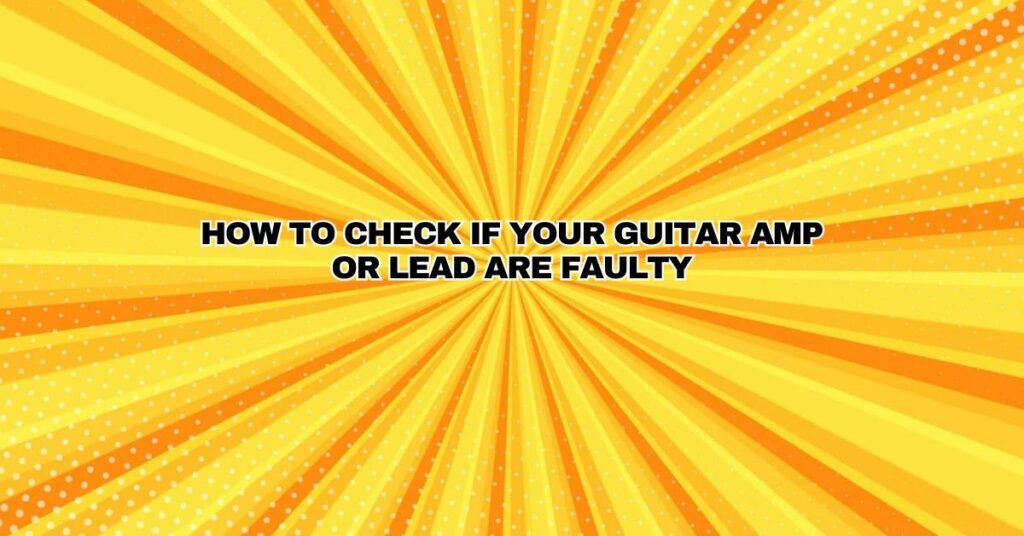Musicians rely on their equipment to produce great sound, and two crucial components of any electric guitar setup are the amplifier (amp) and the instrument cable (lead). When things go wrong, it can be frustrating, and it’s essential to quickly identify the source of the problem. In this article, we’ll explore how to check if your guitar amp or lead is faulty and offer troubleshooting tips to help you get back to making music.
Signs of a Faulty Guitar Amp:
Before diving into troubleshooting, it’s essential to recognize the signs that your guitar amp may be faulty. These signs can include:
- No Sound Output: The most apparent indication of a faulty amp is when you plug in your guitar and nothing comes out of the speakers. This can be due to a variety of issues, from internal component failures to loose connections.
- Crackling, Popping, or Hissing Sounds: If you hear unusual noises, such as crackling, popping, or hissing, when you play your guitar through the amp, it may suggest problems with the amplifier’s circuitry or speaker.
- Inconsistent Volume: Inconsistent volume levels, where the sound goes in and out or fluctuates unpredictably, can be a sign of a faulty amplifier. This could be due to loose connections or damaged components.
- Overheating: An overheating amp can lead to various problems, including sound distortion or complete shutdown. If your amp feels excessively hot to the touch, it’s a cause for concern.
Steps to Check if Your Guitar Amp is Faulty:
To determine if your guitar amp is the source of the problem, follow these steps:
- Check the Power: Ensure that the amp is plugged in, the power switch is on, and the power cable is securely connected. Some amps also have a fuse that may need to be checked.
- Inspect the Guitar Cable: Before assuming the amp is faulty, examine your guitar cable for damage. Frayed or damaged cables can lead to sound issues. Test your cable with another amp or instrument to rule it out as the source of the problem.
- Try a Different Guitar: If you have access to another guitar, try plugging it into the amp. This can help determine whether the issue is with your guitar or the amp.
- Test Different Inputs: Many amps have multiple input channels or jacks. Try plugging your guitar into a different input to see if the problem persists. Some amps also have a high/low gain switch, which can affect the sound.
- Listen for Sound: While playing your guitar, carefully listen to the amp. If you hear any strange noises, crackling, or hissing, it’s an indication of internal issues. These may require professional repair.
- Check the Speakers: If you have multiple speakers in your amp, make sure all of them are working. Sometimes, a single malfunctioning speaker can cause sound problems.
Signs of a Faulty Guitar Lead (Cable):
Guitar leads or instrument cables can also be a source of sound problems. Signs that your cable may be faulty include:
- Intermittent Sound: Sound that cuts in and out while playing is a common sign of a damaged cable. This could be due to loose connections or internal wire breakage.
- Crackling or Popping: If you hear crackling or popping sounds when moving the cable, it may indicate a short or damaged wire inside the cable.
- Sound Dropouts: Sudden sound dropouts while playing can be due to a loose or damaged cable connection.
Steps to Check if Your Guitar Lead (Cable) is Faulty:
To determine if your guitar lead is causing the sound issues, follow these steps:
- Try a Different Cable: The easiest way to test if your cable is faulty is to use a different cable. If the sound issues disappear with the new cable, your original cable is likely the problem.
- Inspect the Cable: Examine your guitar cable for visible damage, such as fraying or kinks in the wire. Pay attention to the connections at both ends of the cable to ensure they are secure.
- Test Different Instruments: Try using the potentially faulty cable with another guitar or instrument. If the issues persist, it’s likely the cable that’s problematic.
- Wiggle Test: Gently wiggle or move the cable at different points while it’s plugged into the amp and guitar. If you hear crackling or notice sound dropouts during these movements, the cable may have an internal break.
Preventing Future Issues:
To minimize the risk of future problems with your guitar amp and lead, consider the following:
- Invest in high-quality cables, as these are less likely to suffer from internal wire breakage or other damage.
- Ensure that your amp and cables are properly stored and protected from physical damage, moisture, and extreme temperatures.
- Periodically inspect your cables for visible signs of wear and tear.
- Avoid pulling or tugging on the cable connectors when plugging or unplugging them, as this can damage the cable’s internal connections.
In conclusion, troubleshooting a faulty guitar amp or lead is a crucial skill for musicians. By recognizing the signs of amplifier and cable issues and following the steps outlined above, you can identify the source of the problem and take appropriate action to resolve it. Regular equipment maintenance and investing in quality components can help prevent future issues and ensure that your music sounds its best.


